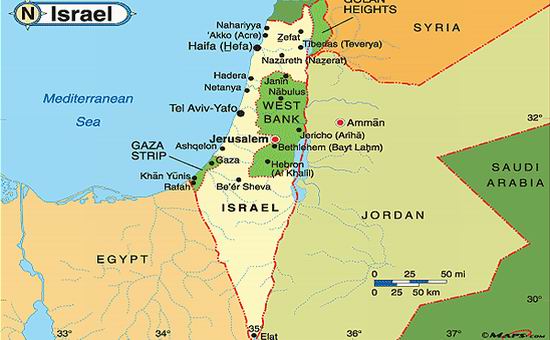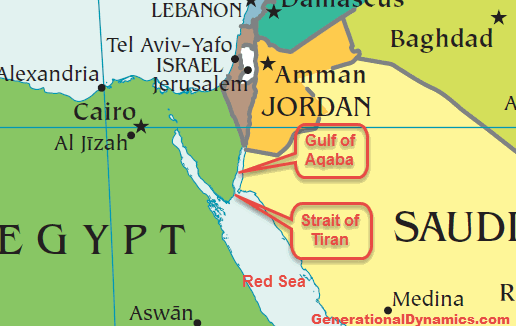What is the issue?
- Recently, the US recognized Jerusalem as the capital of Israel despite its keenly contested status in the Israeli-Palestine dispute.
- This resulted in intense protests by Palestinians at the Israel-Palestine border along Gaza Strip, which was crushed brutally by Israeli forces.
Why did the current sitation arise?
- Ground Situation - Jerusalem has been completely under Israeli control since 1967, and Israelis consider that the city as their eternal capital.
- Notably, Israeli PM Benjamin Netanyahu has his office in the city, and it is the seat of Israel’s Parliament and Supreme Court.
- But almost all other countries see Jerusalem as a disputed city, and its final status is to be decided based on the outcomes of Israel-palestine peace.
- Change - In December 2017, US President Trump broke away from the long standing US policy to recognise Jerusalem as the capital of Israel.
- Subsequently, the US embassy was shifted to Jerusalem on the 70th anniversary of Israel’s founding in 1948.
- This change in status quo has angered Palastinians, which is what led to the current wave of protests and counter responses.
- Crack Down - Palestinian Protesters rushed en-masses towards the Gaza border and seemingly intended to cross over into Israel.
- They were advancing based on call by Islamic clearics to charge on Jerusalem or martyr in that endeavour.
- Sadly, the crack down on protests by Israeli border forces was particularly harsh and resulted in the death of over 60 people.
- In this backdrop, the Hamas Militia that currently wields power in Gaza has given a war cry against Israel and vouched aggression.

- Map: Palestine is presently confined to two disjoint landmasses namely “Gaza Strip and West Bank”. They are seperated by Israeli Territory.
How did Jerusalem become a hotly contested territory?
- The city of Jerusalem is holy to Christians, Muslims and Jews.
- “The Temple Mount” in the city is the holiest site in Jewish religion and Jews from across the world come to pray Western Wall of the Biblical temple.
- “Al-Aqsa mosque”, which is Islam’s 3rd holiest site after Mecca and Medina is also located within the city.
- “Church of the Holy Sepulchre” in Jerusalem is thought to be the site of Jesus Christ’s Resurrection, thereby making it holy for Christians too.
- Partition War - In 1947, United Nations approved the division of British-ruled Palestine into separate Jewish and Arab states.
- Given the unique religious holiness of the city, Jersulaem was proposed as a territory that was to be government by a ‘Special International Regime’.
- But the Arabs rejected the UN plan in its entirety and attacked Israel the day after it was created in 1948, but were defeated in the endeavour.
- Consequently, Israel took control of West Jerusalem, and Israelis declared Jerusalem as an inseperable part of the state of Israel.
- But in the conflict, East Jerusalem, which has the Old City and all the holy sites came under Jordanian occupation (Pro-Arab forces).
How did Israel take over the entire Jerusalem?
- Gamal Abdel Nasser of Egypt announced in 1967 that he would close the Strait of Tiran, which was critical for Israel’s access to Red Sea.

- Consequently, Israel attacked Egypt, which began the fiercely fought 1967 Arab-Israel war, with entire Arab world on Egypt’s side.
- Despite Israel coming under attack on all sides from Syria, Jordan and Egypt, it took only 6 days for Israel to decimate its enemies comprehensively.
- At the end, Israel snatched the Gaza Strip and Sinai from Egypt, West Bank and East Jerusalem from Jordan, and Golan Heights from Syria.
- The victory fired the Israeli morale immensely and the takeover of east-Jerusalem facilitated Jews from praying at the Western Wall (Temple Mount).
What has been the situation since?
- Subsequent Jewish polity reinforced that the idea of Jerusalem is at the heart of the Israeli identify, through outreach programs to its citizenry.
- An Israeli law in 1980 declared the entire city of Jerusalem as the capital of Israel, thereby virtually annexing an occupied territory.
- Peace between Israel and Palestine were negotiated with Norwegian mediation and the Oslo Accords were signed in 1993.
- While these accords created a Palestinian Authority for the West Bank and Gaza Strip, it did not address the status of Jerusalem.
- International status - Palestinians see Jerusalem as their capital city, but the UN recognizes only East Jerusalem as Palestinian territory.
- Notably, this is according to the 1947 border that was proposed by the UN in the partition deed for British ruled Palestine.
- Contrarily, hardliner Jewish nationalists have vowed to retain their current occupation of the entire Jerusalem as Israel’s capital forever.
- US president Trump’s recognition of Israeli claim over Jerusalem will weaken the Palestinian perspective.
- But given the intense sentimental value associated with the city, it will nevertheless remain contested for the foreseeable future.
Source: Indian Express

